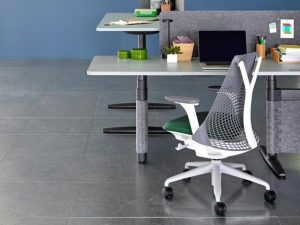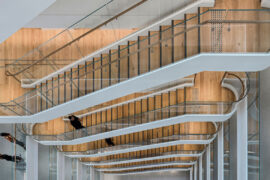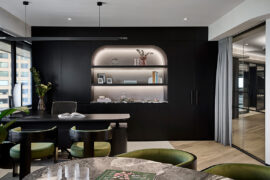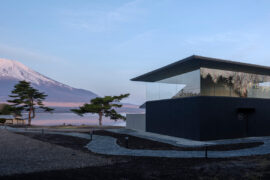‘Ergonomics’ is a term that gets thrown around a lot in the architecture and design industry. But what does ergonomics actually mean in design? And how do designers achieve it?

September 17th, 2017
Ergonomics is the study of how humans interact with the built environment. It is a concept that is particularly prevalent in workplace design, especially as people spend ever-increasing amounts of time at work.
There are a handful of ergonomic essentials that designers should keep in mind when considering workplace projects. Ergonomic chair design and ergonomic desk design are two of the most significant considerations.

For optimal chair ergonomics, the chair should be set so that your arms are as close to horizontal with the desk as possible, with knees bent at a comfortable angle of around 90 degrees, feet flat on the floor. If your feet don’t touch the floor or doing so causes strain, then an adjustable footrest may be needed. The backrest should be adjusted so that when sitting upright, it supports the lower back.
For ergonomic desk design, the desk should be arranged so that the requirements for ergonomic chair design can be met – namely, your arms should be bent at around 90 degrees, forearms parallel to the floor. The same applies if using a standing desk: arms should be bent at a comfortable angle, with forearms parallel.
There is no one-size-fits-all approach to ergonomics. Each individual will have unique needs for the design of their chair and desk to achieve optimal ergonomics for them.

INDESIGN is on instagram
Follow @indesignlive
A searchable and comprehensive guide for specifying leading products and their suppliers
Keep up to date with the latest and greatest from our industry BFF's!

Welcomed to the Australian design scene in 2024, Kokuyo is set to redefine collaboration, bringing its unique blend of colour and function to individuals and corporations, designed to be used Any Way!

It’s widely accepted that nature – the original, most accomplished design blueprint – cannot be improved upon. But the exclusive Crypton Leather range proves that it can undoubtedly be enhanced, augmented and extended, signalling a new era of limitless organic materiality.

How can design empower the individual in a workplace transforming from a place to an activity? Here, Design Director Joel Sampson reveals how prioritising human needs – including agency, privacy, pause and connection – and leveraging responsive spatial solutions like the Herman Miller Bay Work Pod is key to crafting engaging and radically inclusive hybrid environments.

Gaggenau’s understated appliance fuses a carefully calibrated aesthetic of deliberate subtraction with an intuitive dynamism of culinary fluidity, unveiling a delightfully unrestricted spectrum of high-performing creativity.

Brad Krauskopf, CEO & Founder of Hub Australia, tells us about Hassell’s design for Hub Australia Martin Place.

Setting the tone for McCormack’s HQ is Elton Group’s Eveneer WoodWall and Eveneer Raw in Ravenna – wrapping walls, ceilings and bespoke joinery in a dark, matte elegance. The seamless pairing delivers a cohesive, high-performance finish that anchors Studio 103’s luxurious, hotel-inspired workplace design.
The internet never sleeps! Here's the stuff you might have missed

Melbourne is the destination and Saturday 6th September is the date – get ready for this year’s one-day design extravaganza with a full guide to what’s on.

With prime views over Japan’s Mount Fuji, Yū Momoeda’s sauna facility defies typical standards to respond to the undulations of nature.